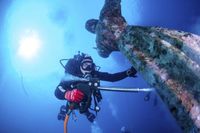Just off the rugged northern coast of Italy, beneath the gentle waves of the Ligurian Sea, a remarkable bronze figure stands watch over the blue expanse. The "Christ of the Abyss" statue, arms outstretched in a silent blessing, has been a steadfast guardian of the Mediterranean since 1954. On August 19, 2025, police divers once again descended into the bay of San Fruttuoso, armed not with metal brushes or abrasive tools, but with pressurized water hoses—ready to perform their annual act of preservation on one of the sea's most cherished monuments.
This 2.5-meter-tall statue isn’t just a diving attraction; it’s a poignant memorial to those lost at sea. Crafted from the melted-down medals of Italy’s fallen soldiers, as well as canons and ships, the statue is a potent symbol of sacrifice from World War II, according to the Associated Press. Its location, about 300 meters off the beach between the picturesque resort towns of Portofino and Camogli, makes it both accessible and mysterious—a silent sentinel at a depth of 18 meters, visible even to kayakers and paddleboarders gliding above.
The site is no ordinary underwater curiosity. The archaeological office of Italy's Culture Ministry has called it the most frequented dive spot in the Mediterranean, thanks in part to its proximity to the coast and relatively shallow depth. For many, the journey underwater is a pilgrimage of sorts, a chance to pay respects and marvel at a union of art, history, and the sea’s quiet beauty. But as with all things exposed to the elements, time and tide take their toll.
Every year, the statue is gently cleaned by police divers using seawater itself—a method believed to have zero impact on the surrounding marine ecosystem. Alessandra Cabella, an art historian from the Ligurian archaeology superintendent’s office, explained to the Associated Press, "There are a ton of marvelous fish who come to watch. It’s truly an activity with zero impact on the environment." The cleaning process dislodges bacteria and corrosive crustaceans that accumulate on the bronze, sending them swirling harmlessly back into the sea. It’s a spectacle not just for divers, but for the curious fish that gather to observe the commotion—nature’s own onlookers.
This careful maintenance is a relatively new chapter in the statue’s story. The water-blasting technique has only been in use since 2004, when the statue underwent a full restoration after one of its hands broke off and had to be re-attached. Before then, the approach was far less gentle: workers would scrape the bronze with metal brushes, a method that, in hindsight, did more harm than good. The abrasive cleaning left crevices in the bronze patina, creating tiny pockets that only encouraged more marine material to accumulate. According to Cabella, those earlier efforts caused "irreparable damage" to the statue’s surface—a hard lesson in the delicate art of underwater conservation.
The statue’s vulnerability isn’t limited to its surface. When Italian artist Guido Galletti created the "Christ of the Abyss" to honor a diver who died in the area, he designed it to withstand the sea’s powerful currents. The statue was filled with cement and iron rods for stabilization, anchoring it firmly to the seabed. But this practical choice came with a hidden cost. The presence of iron, Cabella noted, has helped corrode the bronze from the inside—a slow, insidious process that makes gentle, non-invasive cleaning all the more essential.
Despite these challenges, the "Christ of the Abyss" endures, its arms raised in perpetual benediction. Over the decades, it’s become more than a memorial; it’s a living part of the coastal community. Locals and visitors alike are drawn not just by the statue’s history, but by the sense of peace and wonder it inspires. The fact that it can be seen from the surface only adds to its allure, attracting not just divers but kayakers and paddleboarders eager to glimpse its serene silhouette beneath the waves.
It’s not the only statue of its kind. According to the Associated Press, similar "Christ of the Abyss" statues can be found off Key Largo, Florida, and in Grenada, each a tribute to those lost to the sea and a testament to the enduring power of remembrance. But the original, nestled between Portofino and Camogli, holds a special place in the hearts of Italians—an enduring symbol of sacrifice, resilience, and the quiet heroism of those who never returned from the deep.
The annual cleaning ritual has become a kind of underwater festival, drawing not just marine life but a steady stream of human admirers. Dive schools in the region often plan trips to coincide with the post-cleaning period, when the statue gleams just a little brighter, freed from its crusty overcoat. For many, it’s a highlight of the Mediterranean diving calendar—a chance to witness both the artistry of Galletti and the ongoing care that keeps his creation intact.
Behind the scenes, the Ligurian archaeology superintendent’s office and the Culture Ministry have worked closely to ensure that the statue’s preservation is handled with the utmost care. The shift to water-blasting was a turning point, a recognition that sometimes the best way to protect the past is to let nature do the heavy lifting. By using seawater and gentle pressure, the divers avoid introducing harmful chemicals or causing further damage—a win for both art and the environment.
Of course, the statue’s continued survival isn’t guaranteed. The internal corrosion caused by the iron rods remains a concern, and experts keep a watchful eye on its structural integrity. But for now, the "Christ of the Abyss" stands strong, a beacon for divers, historians, and all who find solace in the mysteries of the sea.
As the sun sets over the Ligurian coast and the bay of San Fruttuoso returns to its tranquil state, the statue remains—a silent witness to the passage of time, a bridge between the living and the lost, and a reminder that even beneath the waves, memory endures.

